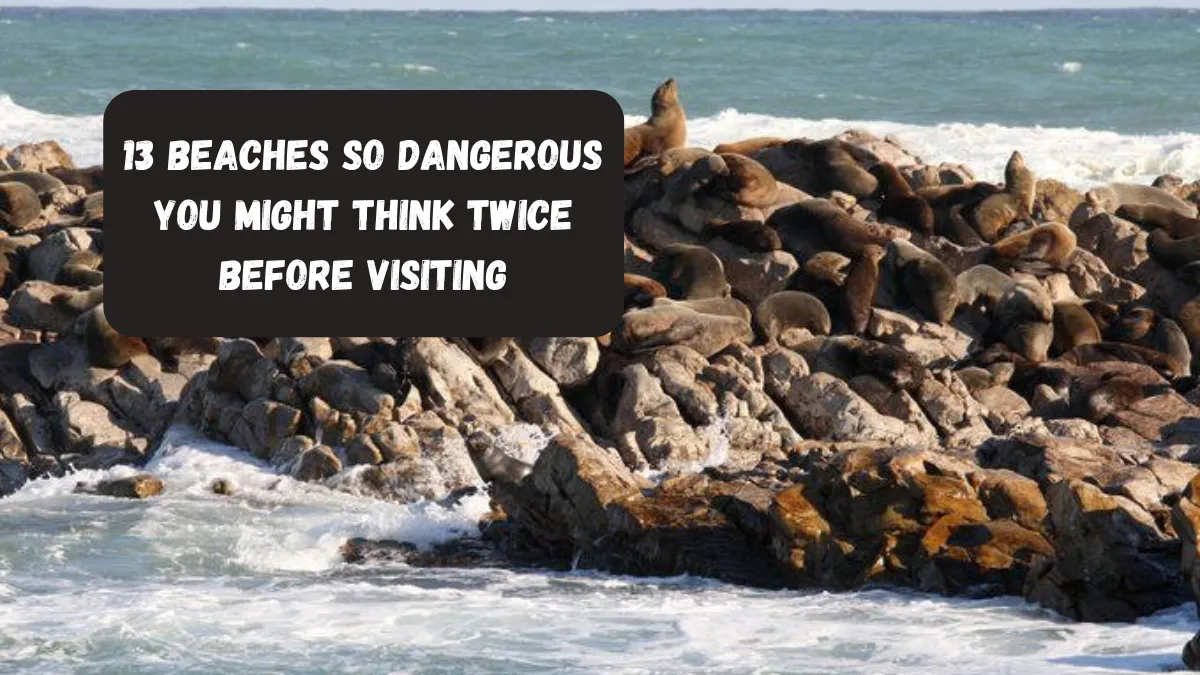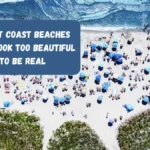When we think of beaches, we often picture paradise—soft sand, clear water, and warm sun. But not all beaches are as safe as they appear. Some are notorious for hidden dangers that can turn a dream vacation into a nightmare. From deadly rip currents and shark-infested waters to toxic pollution and active volcanoes, these beaches may look stunning but are extremely hazardous.
Whether it’s in Australia, Hawaii, or India, each location on this list has a reputation that should make you think twice before diving in. This blog explores 13 of the world’s most dangerous beaches, highlighting the specific threats and why you need to stay alert if you ever visit them. If you’re a thrill-seeker or just a cautious traveler, knowing the risks can help you enjoy your trip without putting your life in danger. Read on to discover which beaches you might want to admire—from a safe distance.
1. Hanakapiai Beach, Hawaii
The Nā Pali Coast of Kauai in Hawaii is home to Hanakapiai Beach, which is famous for both being very beautiful and very dangerous. The beach’s white sand and blue water may look nice, but there are strong rip currents that can take swimmers out to sea in an instant. There are no lifeguards on duty, and the closest help is miles away, which makes it very hard to save people.
Even though there are warning signs everywhere, tourists often don’t read them because the beach is so beautiful. The risks are raised even more by strong shore breaks and waves that are hard to predict. Some bodies have never been found because of how strong the currents are. Dozens of people have died here over the years. People who are very good at swimming have been in scenarios where their lives were in danger. When you go to Hanakapiai Beach, you should be very careful because it’s a sharp warning that nature’s beauty can also be dangerous.
2. Cape Tribulation, Australia
The lush beauty of Cape Tribulation in Queensland, Australia, is in the Daintree Rainforest. However, it is also one of the world’s most dangerous beaches. The wide range of dangerous animals that live in this area makes it a very dangerous place to visit. Box jellyfish live in the water from October to June. Their stings can kill you in minutes by stopping your heart. It’s not always safe, even when you wear protective clothes. Along with sea creatures that can hurt you, saltwater alligators are known to hang out near the shore.
These animals are dangerous and can move very quickly. There are also poisonous snakes and bugs in the jungle, which makes it even more dangerous. Cape Tribulation has a lot of natural beauty and wildlife, but people who go there need to be very careful and follow all safety rules. It’s a place where one wrong move could put you in danger with some of nature’s most dangerous animals.
3. New Smyrna Beach, Florida
A lot of people call Florida’s New Smyrna Beach the “shark bite capital of the world.” There are a lot of sharks in the water, mostly blacktip and spinner sharks. The beach is a famous place for surfers because the waves are always the same. Because the Ponce de Leon Inlet is close by, the conditions are great for both fish and animals that hunt them. Sharks often mistake human parts for prey when they are eating because the water is so shallow. Most bites don’t end in death, but they can be very painful and frightening.
Every year, more sharks bite at this beach than at any other beach in the world. Even though there are numbers to the contrary, a lot of people still come here, often without realizing the dangers. There are lifeguards and warning tools in place, but they can’t completely remove the risk. If you want to swim or surf here, you need to be very careful and aware.
4. Fraser Island, Australia
The world’s biggest sand island is Fraser Island, also called K’gari. It is off the coast of Queensland, Australia, and is a UNESCO World Heritage Site. It has beautiful scenery, like freshwater lakes and green jungles, but it is also very dangerous. The water around Fraser Island is not safe for swimming because there are strong rip currents and a lot of marine stingers, such as Irukandji jellyfish. Also, one of the most dangerous groups of dingoes in Australia lives on the island.
People, especially kids, can be seriously hurt by these wild dogs. People who camp or walk are often told not to feed them or get close to them. Because the island is so far away and doesn’t have any hospitals, it’s hard to get help in an emergency. Tourists are told to be very careful and strictly follow the rules in the area. Fraser Island is definitely beautiful, but it’s also a dangerous place to visit because of the risks in the water and on land.
5. Gansbaai, South Africa
People all over the world know Gansbaai as the “Great White Shark capital of the world.” Cage diving is popular with thrill-seekers and travelers because it lets them get close to these top predators. But the thing that makes this beach so popular is also what makes it so dangerous. A lot of great white sharks live in the water near Gansbaai because of the seal colony on Dyer Island, which the sharks use for food.
Because of the high risk of shark strikes, you should not swim or surf in these areas. Aside from sharks, the sea is also very rough, with strong currents and cold water that can quickly make you hypothermic. The area is watched over, and safety precautions are taken for tourists, but this beach is a very dangerous place to be because of the animals that live there. Gansbaai is not for people who are easily scared.
6. Chowpatty Beach, India
While Chowpatty Beach in Mumbai, India, may not be as dangerous to wildlife as some of the other beaches on this list, it is still thought to be unsafe because of its high level of pollution. The beach is one of the dirtiest in the world. The sea has a lot of dangerous bacteria and waste from factories in it. There are dangerous diseases, rashes, and breathing problems that can happen if you swim here. The beach is also known for having a lot of garbage on it, which makes it dangerous to swim and even to walk on barefoot.
Even though Chowpatty Beach is a lot of fun during fairs and public events, it is still bad for people’s health. The lack of proper trash management makes it even worse for tourists who come to visit. There have been attempts by the government to clean up the area, but it is still very dirty. For people who care about their health and cleanliness, this beach is best enjoyed from afar, not up close.
7. Playa Zipolite, Mexico
People in the area call Playa Zipolite, which is on the southern coast of Oaxaca, Mexico, the “Beach of the Dead,” and for good reason. The beach is famous for its dangerous rip currents, even though it has beautiful scenery and a laid-back vibe. People who are good at swimming can get swept away in seconds by these strong currents that are hard to see. Over the years, many people have died on the beach, which is how it got its scary name. There is now a volunteer lifeguard team in the area, but the risks are still high.
There are warning signs all along the beach, but because the water looks calm, people often don’t realize how dangerous it is. It is especially not a good idea to swim at night because it is more dangerous. Playa Zipolite is also a nude beach that draws tourists with a free spirit, but everyone needs to be very careful in the water. Here, beauty and danger live together in a way that is memorable and dangerous.
8. Dumas Beach, India
The Indian state of Gujarat has a beach called Dumas that is known for its black sand and creepy vibe. During the day, both locals and visitors like to hang out at the beach. At night, though, it has a much scarier vibe. Many reports and local stories say it’s haunted, with tales of ghost sightings and other strange things happening. But what really makes Dumas Beach dangerous are the waves that come and go and the areas that feel like mud.
Several people have drowned or gone missing over the years because of these secret dangers. The beach doesn’t have enough signs or lifeguards, which makes it more dangerous for people who don’t know what’s going on. Also, if people aren’t careful, the falling tide can leave them stuck or even sweep them away. Even though Dumas Beach has a strange allure, it’s not a good place to go at night or for long, exciting walks away from people. People who are there should be careful not to get too close to the water.
9. Kilauea Beach, Hawaii
Kilauea Beach in Hawaii is one of the most interesting and dangerous beaches in the world. It is right next to the active Kilauea Volcano on the Big Island. The beach is beautiful to look at with its black sand and dramatic scenery, but the nearby volcano is active and could cause problems. Toxic fumes, such as sulfur dioxide, can drift into the area and make it uncomfortable to breathe and irritate the skin. Also, rapid lava flows or steam sources may appear out of the blue. Volcanic action can also cause earthquakes that make things more dangerous.
People also say that the beach is dangerous to swim in because of its strong currents and sudden drops. Not many, if any, lifeguards are on duty, and the warning signs might not always show how things are in real time. People who go to this beach need to be very careful because of the dangerous water conditions and volcanic risks. For people who don’t know the area well, looking at it from afar is often the best option.
10. Boa Viagem Beach, Brazil
Boa Viagem Beach in Recife, Brazil, has a warm beach lined with palm trees that makes it look like a tropical dream. The beach is one of the most dangerous in the world, though, because so many sharks attack there. Changing the environment by building a nearby port, which took away the sharks’ native home, is linked to the rise in attacks. Because of this, species like bull sharks have moved closer to the shore, making it more likely that they will come into contact with people. There have been dozens of attacks on the beach, and many of them have been deadly.
People still swim in dangerous areas even though there are warning signs and roped-off areas because the beach is so beautiful. Lifeguards watch over the area, but they can’t stop everything that could go wrong. Boa Viagem Beach is a warning about what can happen when people do things that aren’t supposed to happen to marine ecosystems. People who want to go into the water must carefully consider the risks.
11. Utakleiv Beach, Norway
Photographers and tourists from all over the world come to Norway’s Utakleiv Beach to see the beautiful Arctic scenery. It might not be as dangerous right away as beaches with sharks or a lot of trash, but it does have its own major risks, especially when it’s cold and windy. The Norwegian Sea is very cold and can make you hypothermic in just minutes. This makes swimming very dangerous even in the summer. People can get blown off rocks or dragged into the water by strong winds and waves that don’t stop.
Because it is so far away, there aren’t many emergency services nearby, and help could take hours to get there. A lot of tourists don’t realize how quickly the weather can change in this area, which makes it even more dangerous. Even though the beach is beautiful and has amazing views of the Northern Lights, it’s not a good place to swim or do water sports. When you go to Utakleiv, you must have the right gear and take the right measures.
12. Skeleton Coast, Namibia
Many people have said that Namibia’s Skeleton Coast is one of the most beautiful and lonely stretches of beach in the world. Its name comes from the many shipwrecks and animal bones that are washed up on the shore. People come to see its stark, strange beauty, but it is also very unpleasant to live in. The Atlantic Ocean here is very rough, with big waves and dangerous currents that make swimming very risky. The coastal fog, which is made when cold air from the sea meets hot air from the desert, makes it hard to see and makes visitors feel lost.
Also, there aren’t many places to get fresh water, and living in the desert would be hard in an emergency. Rescue services are hard to come by because the area is so far away. To drive to the area, you need to plan ahead and make sure your car has all the tools it needs. Adventurers, not casual beachgoers, should go to the Skeleton Coast. To explore safely, you need to show respect and be ready.
13. Praia de Norte, Portugal
Surfers all over the world love Praia de Norte in Nazaré, Portugal, because it has waves that break records and can reach heights of over 100 feet. Huge waves like these are caused by an underwater tunnel that directs and amplifies ocean waves that are coming up to the shore. This makes it a great place for expert big-wave surfers, but it also makes it one of the most dangerous beaches for swimmers and surfers who have never been there before. Even for trained athletes, the waves’ sheer power can kill them.
Rip currents are very strong, and the rocky ground makes it more likely that someone will get hurt. During surfing season, there are lifeguards, but they can only do so much because the waves are so rough. Praia de Norte is not a good place for swimming or surfing for the first time. Anyone can watch the action from a safe distance, but getting into the water without the right training and gear could be highly dangerous.
Bottom Line
While beaches are often seen as relaxing getaways, some come with serious and even life-threatening risks. From powerful rip currents and wildlife encounters to pollution and unpredictable weather, the beaches listed here prove that natural beauty can hide real danger. It’s essential to do your research before visiting any beach, especially those known for extreme hazards. Safety should always be your top priority, no matter how beautiful the destination appears. If you’re planning a beach vacation, stay informed, heed warnings, and never underestimate the power of nature. Sometimes, the safest way to enjoy these beaches is from the shore.
FAQs
Why are some beaches more dangerous than others?
Certain beaches are more dangerous due to natural factors like strong rip currents, shark activity, unpredictable tides, or the presence of deadly wildlife.
Is it safe to visit these beaches just for sightseeing?
Yes, most of these beaches are safe to visit if you stay onshore and follow posted safety guidelines. Avoid swimming or venturing into restricted areas.
What should I do if I get caught in a rip current?
Stay calm, don’t fight the current, and swim parallel to the shore until you’re out of the current. Then swim back to land at an angle.
Are lifeguards available at these dangerous beaches?
Some beaches have lifeguards, but many remote or hazardous ones do not. Always check local safety conditions before visiting.



